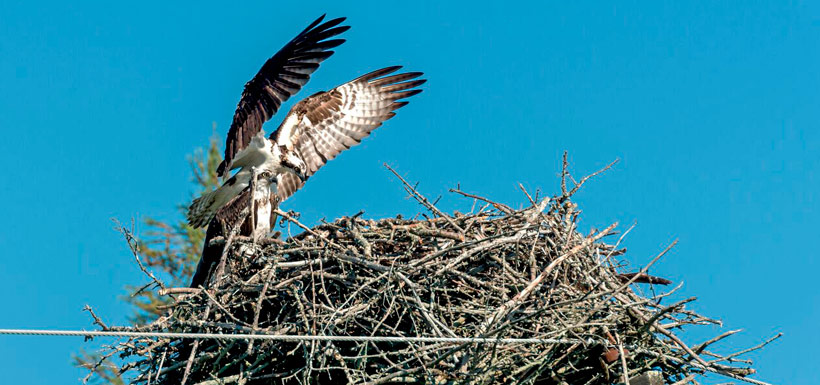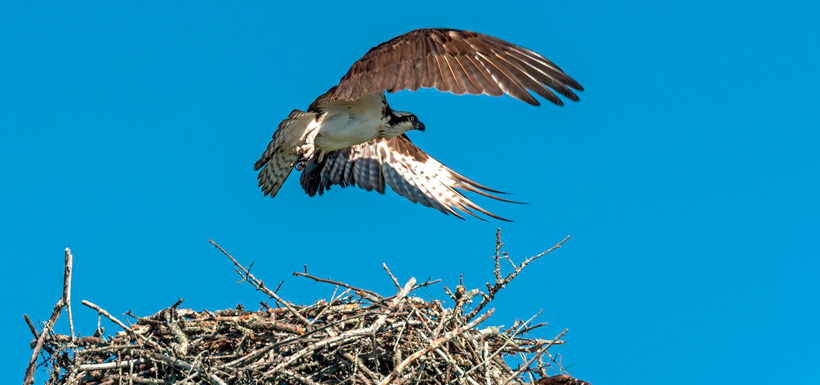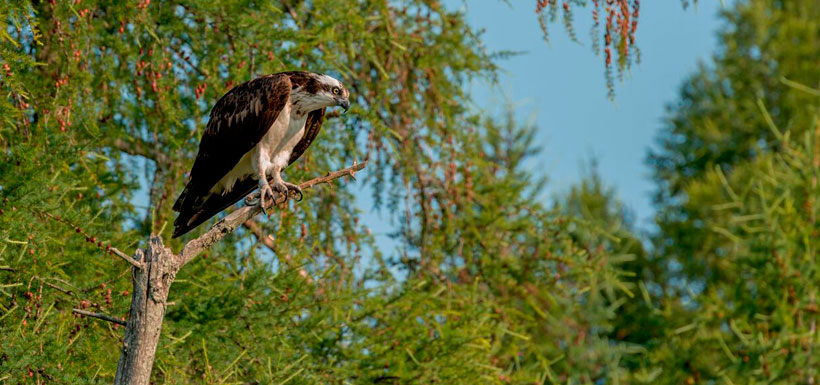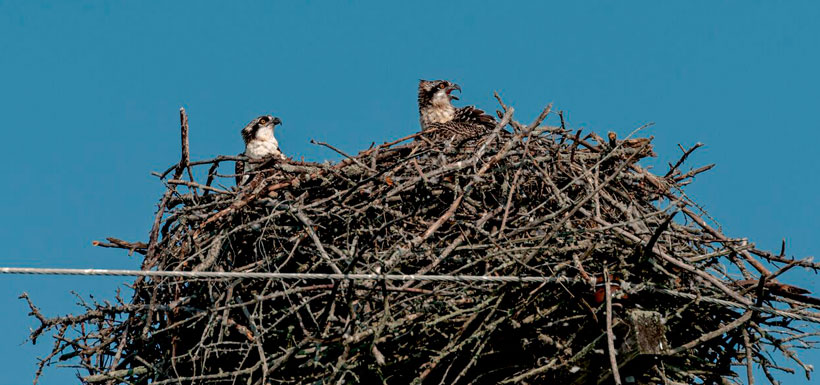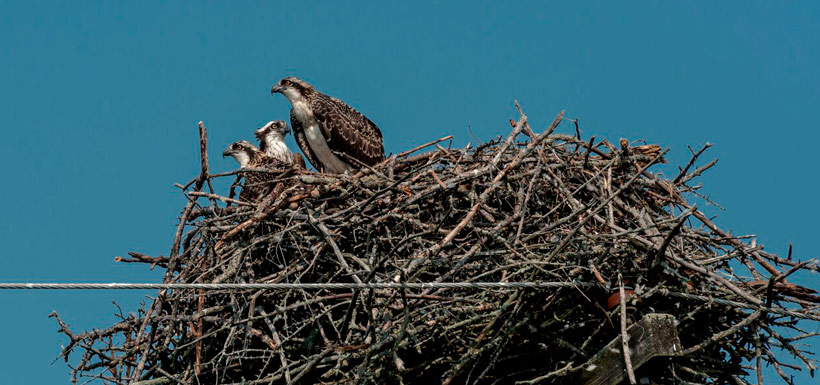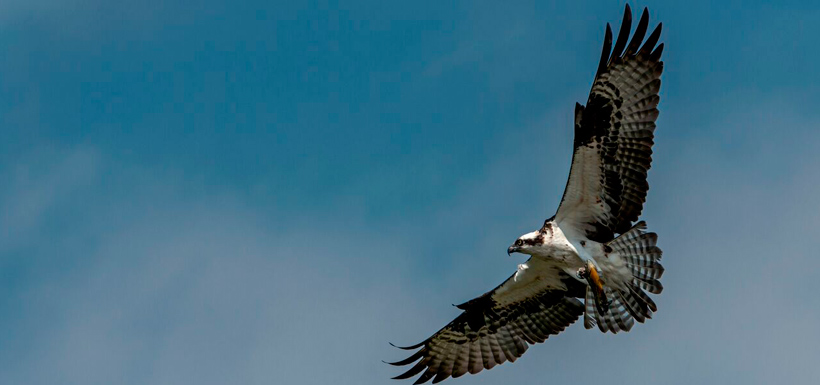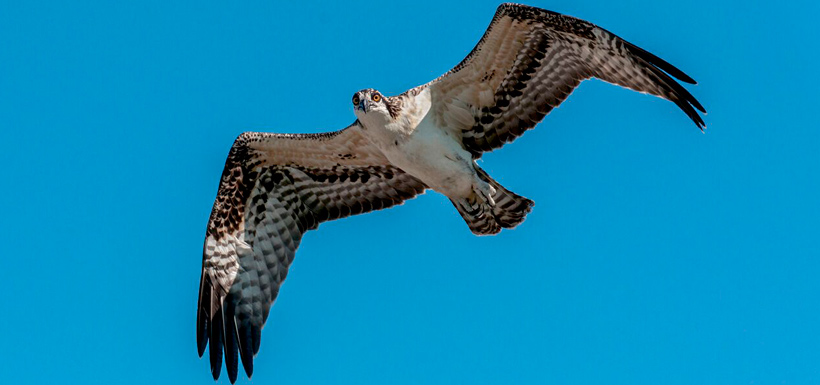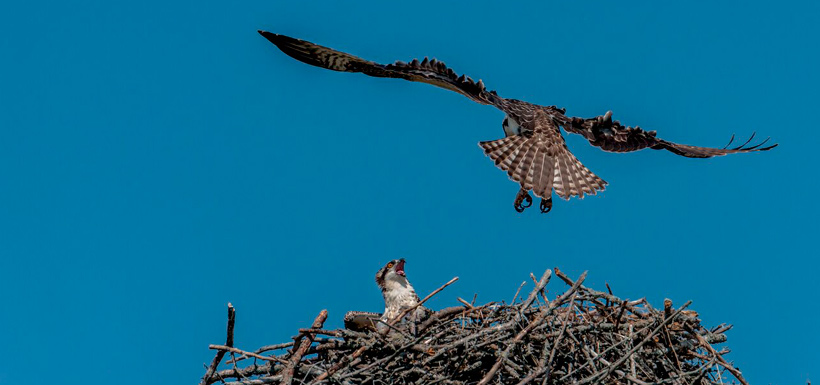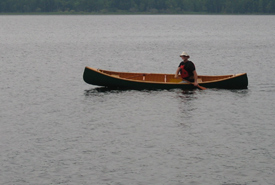An osprey family affair
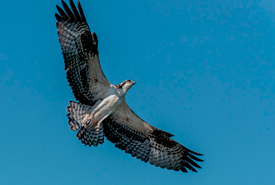
An osprey soars around its nest (Photo by Lorne)
This journey of an osprey family, between early May 2015 and mid-August of the same year, is almost as much my journey as theirs.
It begins as a young boy some six decades ago, when my maternal grandfather would pick me up to spend some quality time in the Kawartha Lakes. While vaguely remembering the buildup leading to these adventures at his cottage on Canal Lake, the imagery and joy when we stopped at a small bakery in Brooklin for a hot dog and butter tart is well ingrained. Food, sweets and a car ride into the “wilderness” made me a lucky kid.
My grandfather was an avid outdoorsman, and in the early 1950s the basement of his Toronto home stored his recent trophies. I remember him showing me how to tie flies using the beautiful, colourful feathers from upland game. While fishing, granddad and I would occasionally drift by in the boat and look into what appeared to be a disorganized stick pile about two metres in diameter and a metre deep Now if it wasn’t that big you’ll have to forgive me but it certainly felt like it could swallow this ten year old and at the time my mind raced to visualize the size of the osprey that Grandad claimed returned to this nest in the spring of each year to start a new family but I never did see them.
Today, as a photographer, I continue to explore woodlands, fields and wetlands in Southern Ontario. One Durham location that frequently brings me contentment and fulfillment is Lynde Shores Conservation Area in Whitby, ON. Depending on the time of year, Lynde Shores Marsh and Cranberry Marsh are teeming with waterfowl. Deer wander the dense brush, only exposed while in the more open fields or as they cross the private road and trails. Unfortunately this also raises concern when I see every osprey platform is empty. There’s no evidence of previous nest accumulation and other than the occasional passerby overhead, there are no paired residents.
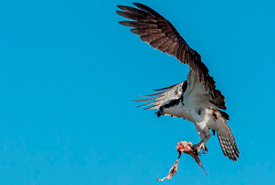
Osprey brings fish to hungry babies (Photo by Lorne)
Now it’s possible these nesting platforms will remain empty for some time yet to come because osprey, while often returning to their birth area, won’t actually return to breed until their third to fifth year, according to the research published by the Cornell Lab of Ornithology. I mention this because the empty platforms at Lynde Shores are in stark contrast to the literally hundreds of nesting platforms lining rural roads a short drive north into the Kawartha Lakes.
In early May this year, I asked my friend Jim, a Kawartha Lakes resident, to keep his eyes open for osprey activity. When I got a call from him a few days later that he saw several active nesting platforms, we made some hasty plans to scope things out. Not long after I made what was to be the first of nearly a dozen visits, to observe and photograph one osprey family – and what a journey it became!
Sitting still for up to four hours at a time on the cold concrete skirt of a small bridge, I quickly became non-threatening to this breeding pair. That’s not to say they welcomed my presence, but it was tolerated. This active osprey nest was on a hydro pole platform directly in front of my location; the female sitting on the eggs for close to 40 days in blazing sun, high winds, and driving rain characterized an exemplary parent. It was like she knew and accepted unconditionally her DNA role, chirping loudly and constantly wanting her mate to return with headless fish. This role seldom varied even when the first egg hatched. I believe the second appeared four days later, smaller of course, and less likely to survive unless the food supply continued.
Story continues under slideshow.
Osprey, a large fish-eating hawk, have come back from the edge of virtual extinction. There were measurable, dramatic losses in the period covering the 1950s, 60s and the early 70s. The beginning of their recovery was largely a result of the 1972 Canadian ban on DDT. Print articles clearly show that its widespread use in agriculture resulted in many people and wildlife suffering long-term consequences. There’s simply no denying the correlation that existed between the use of DDT, the thin egg shells of native osprey and peregrines and the disastrously low reproductive rates.
It was wonderful the efforts of witnessing such devoted parents to ensure their brood survives. By late June when one brought in a fish to feed to the rapidly growing and thriving youngsters, the other stood guard close by. Over the next couple of weeks as they became more fully fledged, role reversal became more commonplace. It was wonderful witnessing the efforts of such devoted parents.
Why they chose this particular nesting platform from others along this rural road remains a mystery because each was in an open, safe location with Balsam Lake, a large marsh, and a section of the Trent/Severn system close by. With a good food source this family would flourish and eventually by mid-August, with fledging complete, the adults seemed to spend more time using the nest as a food drop-off box while the juveniles honed new hunting skills. With early migration soon to follow this stage became essential to their survival.
My interpretation might never do this experience justice. In 2015 for at least once a week over a three month period, I sat patiently for hours with camera in hand hoping for at least one good burst.
This particular photography journey allowed me to witness first-hand the growth of two efficient osprey predators and see the commitment of a breeding pair – an experience that left me humbled and extremely grateful.

